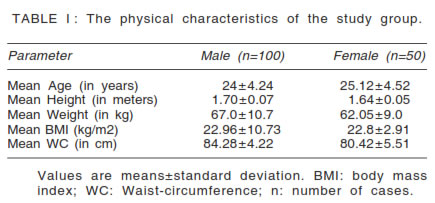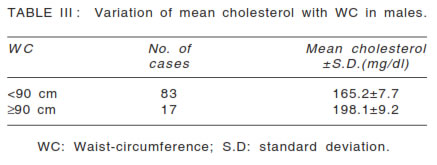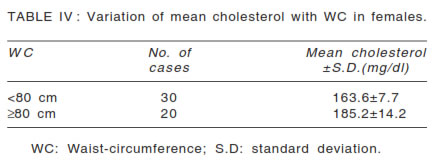and Pharmacology
Indian Journal of Physiology and Pharmacology |
 (252x320).jpg) |
Volume 58 - Number 2 April - 2014 (Current issue) ISSN 0019-5499 |
A study of serum cholesterol level in young adults and its relation to body mass index and waist-circumferenceSoumitra Nath and Wasima Jahan |
The present study was carried out to determine the serum total cholesterol (TC) level in young adults of Dibrugarh town of Assam and to find the association of serum cholesterol level with body mass index (BMI) and waist-circumference (WC). A cross-sectional study was done among 150 healthy young adults aged 2030 years. TC was estimated by the enzymatic method. Hypercholesterolemia was defined as TC > 200 mg/ dl. Cases were classified into different categories of BMI and WC according to the recommendations of WHO/IASO/IOTF (2000). The range of TC level in the study group was found to be (146-212) mg/dl. Mean cholesterol level in males and females were 169.5+13.6 and 172.3+15.09 mg/dl respectively. 7% of the cases had hypercholesterolemia. TC was significantly correlated with BMI (r=0.90, p<0.001) and WC (r=0.73, p<0.001 in males and r=0.86, p<0.001 in females). We conclude that young adults ≥ 20 years of age and especially who are overweight should be advised routine cholesterol testing so that preventive measures can be adopted to avoid hypercholesterolemia and it’s complications in future life. |
Indians have one of the highest rates of Coronary
artery disease (CAD) in the world and are prone to
CAD at a much younger age (1). In healthy young
adults, the serum cholesterol level is a strong
predictor of clinically evident cardiovascular diseases
occurring 25 or more years later (2). The risk of
developing CAD and premature atherosclerosis
increases, as the level of serum cholesterol rises.
The serum Cholesterol level varies from population to population and depends on many factors.
Hereditary factors play the greatest role; however
dietary habits, environmental factors, age, sex and
physical activity also play a part (3, 4). These
findings have stimulated research all over the world
and populations with different dietary habits have been
investigated. Limited information exists regarding the
serum cholesterol level in young adults of Assam.
The present study was conducted to determine the
serum cholesterol level in young adults of Dibrugarh
town of Assam. Another purpose of the study was to
determine if there is any association of the serum
cholesterol level of the subjects with their body mass
index (BMI) and waist-circumference (WC). |
The present study comprised of a total of 150 apparently healthy subjects (100 males and 50 females) aged 20-30 years and was undertaken in the Department of Physiology, Assam Medical College and Hospital, Dibrugarh. Local youths, comprising mostly of medical and paramedical students were chosen as subjects. The cases were selected randomly during the one year period of August 2009 to July 2010. The study was crosssectional in nature with adequate statistical analysis. Subjects having major diseases like hypertension, diabetes mellitus, endocrine diseases, coronary artery disease or those taking any lipid altering medication were excluded from the study group. Written informed consent was obtained from all the subjects. Anthropometric measurements, general examination, and systemic examination were done in each case. The procedures followed were in accordance with the ethical standards of the committee on human experimentation of the institution. Method of measuring serum cholesterol Serum cholesterol was determined using enzymatic method (CHOD-PAP) (5, 6). 12-14 hours fasting blood sample was taken by venipuncture in all the subjects for serum cholesterol estimation. Using a centrifuge machine serum was separated. Within 4 hrs of sample collection, estimation of serum total cholesterol was done manually in the departmental laboratory with the help of Cholesterol kit from (Crest Biosystems, a division of Coral Clinical Systems, Goa, India) and Digital Photo colorimeter from (Instruments & chemicals Pvt. Ltd., Ambala city, India). The desirable cholesterol range in adults is < 200 mg/dl. Serum cholesterol > 200 was categorized as hypercholesterolemia (7). Method of measuring BMI The height of the subjects, who were bare-footed, was measured in metres with a standard Anthropometer and weight was measured in kilogram using a weighing machine. BMI was calculated using the WHO formula : BMI = weight (in kg)/height2 (in m2). Method of measuring WC WC is measured in centimeters to the nearest 0.1 cm, with a standard flexible tape on bare skin, at the midway point between the lowest rib and the iliac crest, at the end of expiration with the person breathing silently. The subjects were classified into different categories of BMI and WC as per the WHO/IASO/IOTF (2000) recommendation for Asian adults (8). In these recommendations, overweight is defined as a BMI > 23 and obesity as a BMI > 25. WC > 90 cm for men and > 80 cm for women is a risk factor for cardiovascular diseases in case of Asian population. Statistical methods Statistical analyses were done using SPSS software.
Student's t-test was done to analyze the quantitative
data and to determine the p value. A level of p<0.05
was used to indicate statistical significance in all
analyses. Pearson's correlation coefficient was
employed to determine the correlation between BMI
and TC level and WC and TC level. |
150 (100 males and 50 females) healthy young adults aged 20-30 years comprised the study population. Characteristics of the study population are presented in Table I. The range of serum cholesterol level in the study
group was found to be (146-212) mg/dl. The mean
cholesterol level in males and females were
169.5+13.63 mg/dl and 172.3+15.09 mg/dl respectively. Out of 150 cases, 93% cases had
cholesterol level < 200 mg/dl and 7% cases had
hypercholesterolemia, i.e. > 200 mg/dl. Out of 150
cases, 59% cases had normal weight, 20% cases
were overweight, 19% were obese and 2%
underweight. |
 |
The variation of mean cholesterol level with BMI From Table II, it is seen that mean TC levels increased from 147 mg/dL in males at the lowest BMI category to 191 mg/dL at the highest category of BMI. Among females, mean TC level increased from 149 mg/dL at the lowest BMI category to 195 mg/dL at the highest BMI level. Variation of mean cholesterol with WC From Table III, it is seen that the mean TC level in males having WC > 90 cm is more than males having WC < 90 cm and from table 4, it is seen that the mean TC level in females having WC > 80 cm is more than females having WC < 80 cm. Statistical analysis The mean cholesterol levels in different BMI categories are presented in Table II. The mean cholesterol values of normal weight cases
were compared with that of overweight. Unpaired twotailed
t-test was performed to find the p-value.
Significant
differences was noted between the two
categories
(p<0.001). Similarly, the mean cholesterol
values
of normal weight cases were compared with
that
of obese. Here again, significant differences was
noted
between the two categories (p<0.001). Pearson's
correlation
coefficient (r) was calculated to find the correlation between TC and BMI. The correlation
coefficient was found to be 0.90, (p< 0.001). |
 |
 |
 |
Variation of mean cholesterol with WC in males is presented in Table III. Here, also unpaired two-tailed t-test showed significant differences between the mean cholesterol level of males with WC <90 cm and males with WC > 90 cm (p<0.01). The correlation coefficient between WC and TC in males was 0.73, p<0.001. Variation of mean cholesterol with WC in females is presented in Table IV. Unpaired two-tailed t-test showed significant differences between the mean cholesterol level of females with WC <80 cm and females with WC > 80 cm (p<0.01). The correlation coefficient between WC and TC in females was 0.86, p<0.001. Thus, in the present study we found a strong positive
correlation between TC and BMI as well as between
TC and WC. |
This study was based on the estimation of serum cholesterol in 150 healthy young adults and its correlation with BMI and WC. In our study, the range of serum TC found is (146-212) mg/dl. In a study conducted on Assamese population by M. Das and M. Saikia, the range of TC in males was (98-206) mg/dl and females (93-236) mg/dl in the age group of 21-30 years (9). Thus, the range in our study is little higher than the above mentioned study. This may probably be because most of our subjects were medical students (under graduate and post-graduate) who lead a sedentary but stressful lifestyle. In another study on dietary fat, serum cholesterol levels and incidence of atherosclerosis in Delhi, the mean TC level in medical students was found to be 174.1+35.3 mg/dl (10). In the present study, the mean TC in males was 169.5+13.6 mg/dl and in females, it was 172.3+15.0 mg/dl. Different studies show high prevalence of hypercholesterolemia in Indian subjects. In the present study, prevalence of hypercholesterolemia was 7% which is significant because of the young age of the subjects. Elevated cholesterol concentration correlates positively with premature CAD, as shown by Stamler et al (11). In some young adults, genetic forms of hypercholesterolemia lead to premature CAD (12). Early detection in these patients allows for earlier introduction of cholesterol lowering therapy. Prospective studies strongly suggest that even moderate reductions of cholesterol levels by diet will substantially reduce long-term risk for CAD (13). Another serious health issue related to young adults is obesity. There are various anthropometric measurements for assessment of obesity. BMI and WC are the two most widely used methods. While direct assessment of fat mass may be a better index of obesity-related health risk, it is difficult to measure this accurately in the field setting. Thus, anthropometry still remains the most widely used method for clinical and epidemiological purposes. In the present study, 19% of the study population is obese when classified according to BMI and when classified according to WC cut offs, 17% males and 20% females were obese. In the present study, a positive correlation was found between the BMI and serum cholesterol. This is in accordance with the study in young Swiss men undertaken by Christoph H Saely et al where they found that serum cholesterol increased with increasing categories of BMI (14). Some other studies also found that the total cholesterol level rises as the body mass index rises (15, 16). Also, a strong positive correlation between serum cholesterol and WC was found. This is in accordance with the study done by the Canadian Heart Health Survey, where it was concluded that WC may be the best single indicator of cardiovascular risk factors including dyslipidemia (17). In the present study, a strong correlation was found between serum cholesterol and BMI and WC. Thus, we can say that increasing BMI and WC may increase the risk of hypercholesterolemia. Hypercholesterolemia and obesity have been proved to be individual risk factors for cardiovascular diseases. Young individuals aged around 20 years are a particularly important group with respect to the study of cardiovascular risk factors. This is the age of the transition from adolescence to young adulthood where, in parallel to changes in working and social status, alterations in lifestyle typically occur. Interventions at this age may be particularly effective to decrease the burden of cardiovascular disease later in life. The present study has got several limitations. The number of cases under study should have been more and from different socio-economic strata. Moreover estimation of the complete lipid profile would have been more helpful in assessing the cardiovascular health of the population under study. But serum cholesterol estimation is a relatively cheap and simple test which can be routinely advised as a screening test to assess the cardiovascular health of young adults. Conclusion The range of serum cholesterol in the present
study was (146-212) mg/dl. The mean cholesterol in
males and females was 169.5+13.63 and 172.3+15.09
mg/dl respectively. The serum cholesterol of 93% of the total cases was in the desirable range and
7% had hypercholesterolemia. A positive correlation
was found between BMI and serum cholesterol
as well as between WC and serum cholesterol.
Thus increasing BMI and WC may increase
the risk of hypercholesterolemia. All young
adults > 20 years of age and especially who are overweight and obese should be advised routine
cholesterol testing once every 5 years so that
preventive measures can be adopted to avoid
hypercholesterolemia and it's complications in
future life. Young adults should adopt a healthy
lifestyle so as to avoid the risk of obesity and
hypercholesterolemia. |
|